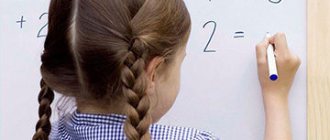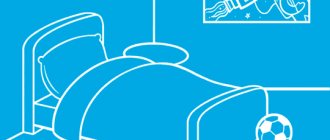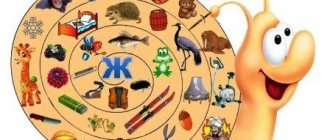One of the important processes of preparing for school is teaching not only writing, but also mathematical literacy. How to teach a child to write numbers?
How to organize a lesson in an interesting and playful way?
If written classes require a specific place, then oral mathematics lessons can be conducted anywhere - on vacation, in transport, on the way home.
Teaching methods
At the moment, the following methods exist:
- Mathematical copybooks (hatching, writing numbers and printed geometric shapes) - designed for joint work between teacher and student. They consist of separate, varied and fun lessons that, in a playful way, help you master writing the numbers from 0 to 9, starting with individual parts and ending with whole numbers. The copybooks differ in color and black and white, cell sizes (small and wide), as well as additional tasks and exercises for the development of logic, thinking, attention and explanations for adults.
- Dotted numbers are one of the most popular methods, allowing the student to quickly and effortlessly remember how to write a particular number. The essence of the training is that the adult is required to put dots or lines in the shape of a number, which the child will have to connect with each other.
- Counting sticks, matches, pencils and other elements are the best way to help kids add the outlines of numbers.
Equally important when teaching the basics of mathematics are number cubes, dominoes, puzzles and other learning materials.
WHAT TO PAY ATTENTION TO?
It is important not only to prepare for writing numbers in words step by step, but also to follow the general rules for teaching preschoolers:
- Lesson duration is 15–20 minutes. Children's fingers get tired very quickly, and they are not yet able to concentrate on a task for a long time. You need to learn to write numbers in words slowly, a little at a time.
- Understanding numbers. The child must clearly understand that a number is not a drawing, not a squiggle on paper. There is a certain meaning behind it (1 is one apple, and 7 is seven apples, which is several times more). For better understanding, it is recommended to simultaneously learn mental counting within 10.
- The right motivation. A common mistake parents make is to motivate their child to indulge in candy, a new toy, or a cartoon. This looks like compensation for something unpleasant. On the contrary, we need to talk about the benefits of knowledge, how good it is to be smart, to be able to write numbers, to study and learn something new.
- Lesson atmosphere and praise. New material must be presented in a friendly and interesting manner. It is useful to use visual, colorful examples and draw analogies. If a child makes a mistake, it is important not to scold him, but to praise him, focusing on the numbers that he was able to write correctly. You can draw a smiley face, a crown, a flower over them.
To write numbers in words, the child must hold the pen correctly - between the index, middle and thumb. Sometimes, for the desired effect, it is enough to press the napkin to your palm with your ring finger and little finger.
Preparation
The main thing when learning is meaningfulness.
- First, parents should conduct oral instruction before writing numbers. Graphic writing of numbers should not be something abstract. The child is required to be able to count to 10, as well as recognize this or that number in printed form.
- Secondly, the baby should be familiarized with the cage. For the first lesson, it is enough to draw a small cell on a landscape sheet and show its center, corners and sides, and also teach the preschooler to find the upper and lower boundaries, all sides of the cell and divide it into four equal parts.
- Thirdly, you should start learning directly after the child can independently draw all the individual elements of a number - sticks, ovals, semicircles and dashes.
Direction of writing numbers
The best age for starting to learn calligraphic writing is considered to be 5-6 years.
Possible problems
The most common difficulty is the child’s desire to mirror the numbers. Until the age of 4-5, such strange writing is absolutely normal. Moreover, the earlier children start arithmetic, the higher the likelihood of mirror writing.
This is due to inaccurate spatial perception - the baby’s brain is simply not mature! Parents should not scold for such “mistakes” and insist on regular classes.
If mirror writing persists after 5 years, it makes sense to consult a specialist, as this may be associated with dysgraphia, a special disorder caused by mental and neurological disorders.
For learning to be successful, the child must not be overloaded. The duration of classes is selected individually. More frequent and shorter sessions are suitable for most children. As with any learning of new skills, maximum attention and patience are required from parents. Only in this case will the baby study with pleasure, and good results will not be long in coming.
What should a child be able to do?
The child should be familiar with tracing the contours of various shapes and lines, be able to color images and confidently hold pencils in their hands.
The student should easily trace the dotted line sticks and hooks.
The correct placement of the hand is also important. A preschooler should know how to accurately hold a pen and sit at a table.
A child who has perfectly developed fine motor skills can easily master writing lessons. Excellent trainers for fingers are modeling from plasticine, polymer clay, salt dough and drawing in an album (from ordinary scribbles to meaningful plot drawings).
Many young mothers begin to get bored while on maternity leave from a series of monotonous tasks. How not to go crazy while on maternity leave? Choose a hobby and develop yourself.
How to put your baby to sleep in 5 minutes? Read useful tips here.
You can see the options for crafts made from matchboxes at the link.
Teaching numbers in a playful way
The light, interesting and bright environment allows the baby to easily remember numbers from 0 to 9 and grasp new material on the fly. Success in learning will be more noticeable if the adult does not focus on the lesson itself, but presents the topic being studied in passing.
After the preschooler gets acquainted with a certain number, it should be drawn on a landscape sheet, preferably in an enlarged size. If desired, the number can be colored with a colored pencil. Further, joint fantasies of the child and the adult are welcomed.
Plasticine numbers
You can make a number from plasticine, roll out puff pastry or any other baking dough, cut out the required number from it and bake in the oven. The baby’s mother can be 100% sure that her son or daughter will not only eat the number she personally prepared with great pleasure, but will also remember the baked number for the rest of her life.
Multi-colored cubes, cards or circles with images of numbers are perfect for reviewing the material covered. The adult should be shown the required element, and the child should accurately guess the required number.
Cookies “Units”
Kids prefer “want” to the word “need,” so each new number should be perceived with enthusiasm. Otherwise, the baby will develop an aversion to learning, which will certainly lead to problems at school.
Learning to write numbers
We all, adults, know how difficult it is for a child to overcome the barrier and begin to confidently write letters in cursive.
Numbers are no exception, although this task seems easier, because printed numbers are almost no different from capital ones. To teach children to write numbers correctly in words, there is one proven method: purchase copybooks and start writing. They can be downloaded from our website online for free.
But what to do if the child does not want to study?
To correctly write the numbers in capital form, ask your child to first circle the patterns. You can use carbon paper and make a translation of the drawing. After this, the numbers can be painted in different colors: this way, memorization will be much faster for children.
Translating pictures using carbon paper is also interesting because the child seems to create the image himself, which means the creative process begins. Let your baby express himself. Even if you want your child to sit down and start writing numbers correctly according to the methodological recommendations of preschool teachers, it’s all the same: push the dry method into the background and give free rein to the child’s imagination. If at this time you quietly slip your child copybooks with pictures, rest assured that writing and recognizing numbers will not be a problem for your first-grader at school.
Make the most of the translation of numbers through carbon paper, pictures, coloring books and between this... copybooks. If you don’t know where to get illustrative materials, you can absolutely easily download and print them on our website.
Learning by association
Abstract numbers mean nothing to a child; for this reason, visual representations are the best way to help children remember certain numbers with ease. For example, a baby’s mother can compare the number 2 with the figure of a swan, 0 with the letter O or a circle, 8 with a matryoshka, etc.
There are several types of associative methods:
- The hanger method helps children remember certain numbers by assigning each number a visual image or a specific word (for example, 1 is an athlete, 5 is an image of a school, 15 is an athlete participating in school competitions).
- Comparing numbers with a specific image - 0 looks like a ball, a sun, a circle; 1 is a toothpick, straw, flashlight, etc.
- O'Brien's method - connecting numbers with the names of famous people. The main principle of the association is number – person – action. For example, 1 is Agnia Barto, 5 is a writer, and already the number 15 is a person who writes poetry.
- Rhymes are combinations of numbers with a certain consonance of words or rhymes.
The child should be taught one associative technique that seems most convenient and easy to remember for an adult. Otherwise, the student will get confused in a large number of difficult-to-understand techniques for memorizing images.
Learning numbers using time and calendar
This method is a type of associative method: each number becomes a kind of reminder for daily activities (for example, seven is wake-up time, nine is kindergarten, three is tea with cookies, five is a walk, etc.).
An excellent replacement for a watch is a calendar with a moving window. Any upcoming event is shown to the baby. The adult must allow the student to manage the calendar independently.
Counting calendar
Naturally, the more colorful the new learning material is, the better the numbers are remembered. Moreover, the numbers in the calendar allow you to teach kids how to count to 31 without much difficulty.
For a more interesting learning experience for adults, it is advisable to prepare a large, bright watch with a round dial and multi-colored numbers. Instead of a calendar, you can keep a diary, come up with a special book of notes or a schedule.
Copybooks
Mathematical copybooks are not just ready-made contours needed for tracing.
The purpose of training is to teach the baby to maintain the correct tilt.
That is, the number 1 should not be written with a vertical stick, but should be started from the middle of the cell, drawn with an inclined line to the upper right corner and smoothly lowered to the lower center.
Copybook assignments allow you to teach your child not only to write numbers correctly and strengthen counting skills from 0 to 9, but also to navigate checkered sheets, develop graphic skills, logical thinking and visual perception. Regular writing activities help improve hand coordination and fine motor skills.
Russian copybooks differ from American and other foreign textbooks, since the principles of writing ones, sevens and nines have some differences.
HOW TO ADDITIONALLY TRAIN YOUR ARM?
Writing is a complex skill that requires subtle, well-coordinated hand movements. In order for a child to easily master it, it is necessary to train the strength and dexterity of his fingers, teach him to navigate in a notebook sheet (quickly find the desired object, move in a given direction). He must notice proportions and reproduce them correctly on paper.
Therefore, in addition to working with copybooks, from the age of 4 it is useful to conduct classes in graphomotor skills (from the Greek grapho - “I write”). They include:
- shading;
- drawing graphic patterns;
- outline outline;
- finishing details;
- exercises where you need to apply different pressure forces;
- tasks for choosing the right directions (labyrinth);
- tasks where you need to draw lines without lifting your hand;
- finger games.
Examples of graphomotor activities:
So, a child begins to write numbers correctly in words at the age of 5–7 years. Skill development occurs in stages. If you miss any point, working with copybooks will be difficult. A lack of understanding of how to do a particular task and poor finger coordination can cause a baby to become very upset and cry. The parent should not be nervous or angry, but calmly return to the initial stages of learning. Classes should be held in a friendly atmosphere. Come up with new exercises and exciting tasks, then the child will be drawn to knowledge and will already feel confident at school!
Writing rules
The first numbers should be shown to the baby on a large sheet of paper. An adult needs to be patient and thoroughly explain to the student the various details of the numbers (straight and wavy lines, oval, semicircle) and the rules for writing them: where to start the line, in which direction to go, when to lift the pen from the sheet and where to end.
So:
- Number 1 – you need to start from the center of the cell, move smoothly to the upper right corner and lower it to the center of the cell.
- Number 2 – starts just below the middle of the center of the cell. The point is drawn in a line upward and then rounded in the upper right corner of the cell, drawn downward with a slant to the left and ends with a lower wavy line.
- Number 3 is two semi-oval lines. It needs to start from the middle of the cell, lead with a curve to the upper right corner, lower it down just above the middle of the cell and repeat the oval, leading to the lower left corner.
- Number 4 - starts from the middle of the top cell, runs a straight line down to the middle, continues to the right, but not to the end, and ends with a long stick, which starts from the upper right corner and ends in the middle of the cell.
- Number 5 - consists of three parts: a straight line from the upper middle of the cell to its center, a semicircle on the right side of the cell and the final upper wavy line, which is drawn from left to right.
- Number 6 is written in one continuous line; the pen should not be lifted from the sheet of paper. The number starts with a semi-oval from the upper right corner of the cell, draws a line to the bottom, rounds it into a circle at the bottom and ends just above the center of the cell.
- Number 7 - starts with a wavy line just to the left of the upper side of the cell, goes to the right and drops in a straight line to the middle of the lower side, which at the end must be crossed out with a long straight stick.
- The number 8 is drawn in an oval line from the middle of the left side of the cell, moves in a semicircle to the right side, touching its side, smoothly falls to the left and is again rounded into the middle of the cell, touching the starting point of the number.
- Number 9 – starts from the middle of the right side of the cell, goes up, smoothly rounds to the starting point, then the line with a bend descends to the lower part of the middle of the cell.
- Number 0 – represents an oval and starts from the middle of the right side of the cell, goes up, goes down and returns to the starting point.
At 3 years old, a child begins to try to do everything on his own, but he does not always succeed. Psychologists identify a crisis at the age of 3 in a child. At this moment, parents should be especially attentive to changes in the baby’s behavior.
We make crafts with a child from cereals - see product options on this page.
The child needs to be given time to master new material. You can diversify written lessons with playful moments, allow your child to “teach” his favorite bear on his own, play with toy numbers, etc.
The article introduces adults to the basic rules of writing numbers and popular teaching methods. Practical recommendations for working with preschoolers will help inexperienced parents independently teach their kids to write numbers correctly.











